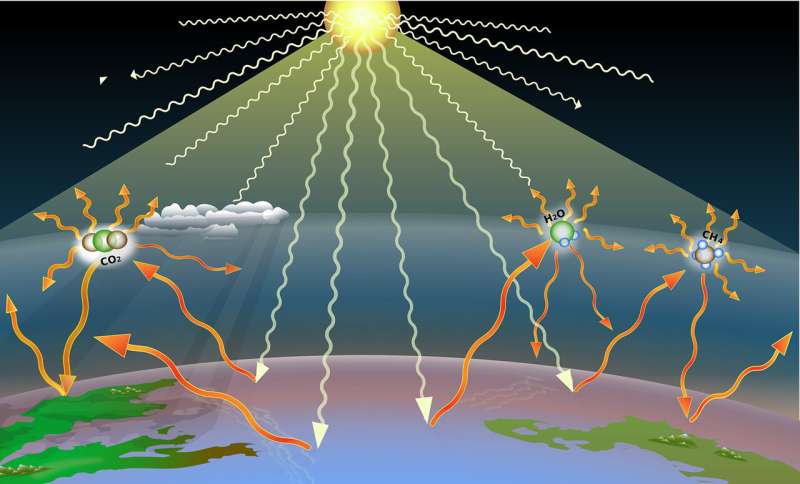Sunlight (white arrows) is converted to thermal radiation on the Earth’s surface, which is then reflected (orange arrows). Part of this is absorbed by greenhouse gas molecules (water vapor, carbon dioxide and methane) and re-emitted in an arbitrary direction, partially back to Earth. Credit: Wikimedia / A loose necktie
Solar radiation enters the Earth's atmosphere without any hindrance and should normally leave it as heat. Unfortunately, this is impeded by the thickening "greenhouse roof" consisting of carbon dioxide and other gases.
That is why the Earth is getting warmer—and our climate is doing so as well. In order to continuously measure the extent of the greenhouse effect, infrared measurement devices, so-called pyrgeometers, are used. The long-term reliability of these measurements has now been significantly improved. This has been made possible by calibrating the pyrgeometers with a new reference device developed by PTB, which is described in the current issue of Metrologia.
The measure for the greenhouse effect is the atmospheric longwave downward radiation, which is the radiation that is reflected from the "greenhouse roof" back to Earth. For years, it has been continuously measured using pyrgeometers located on Earth. These infrared measurement devices cover a broad spectral band, i.e., they capture many wavelengths.
Also, they cover a very wide angle so that they can monitor almost the entire hemisphere of the sky. To ensure the informative value and the comparability of the measurement data over the long term, pyrgeometers need to be regularly calibrated, i.e., metrologically traced to standards.
The new reference blackbody, called the "hemispherical blackbody" (HSBB), is such a standard. It was developed at PTB in cooperation with the Physikalisch-Meteorologisches Observatorium Davos / World Radiation Center (PMOD/WRC) within the European series of research projects titled "Metrology for Earth Observation and Climate" (MetEOC).
The HSBB fulfills the specific requirements for such calibrations and is traceable to the International Temperature Scale ITS-90 via PTB's Radiation Temperature Scale and hence to the SI, the International System of Units. With this, there is now a second independent type of traceability procedure available in addition to the one at PMOD/WRC, which has, to date, been based on contact thermometry and optical simulations.
At the same time, the agreement observed between the radiometric scales for irradiance of the PMOD/WRC and of PTB serves to validate the previously established traceability. Discrepancies that have been encountered to date in the worldwide measurements of atmospheric longwave downward radiation can now be ruled out, and this radiation can now be measured more accurately.
"Everything that helps us to determine the extent of the greenhouse effect more accurately brings us one step closer to estimating the effect of countermeasures in a better and faster way," says PTB physicist Christian Monte.
More information: Moritz Feierabend et al, Bilateral comparison of irradiance scales between PMOD/WRC and PTB for longwave downward radiation measurements, Metrologia (2023). DOI: 10.1088/1681-7575/acbd51
Journal information: Metrologia
Provided by Physikalisch-Technische Bundesanstalt
























